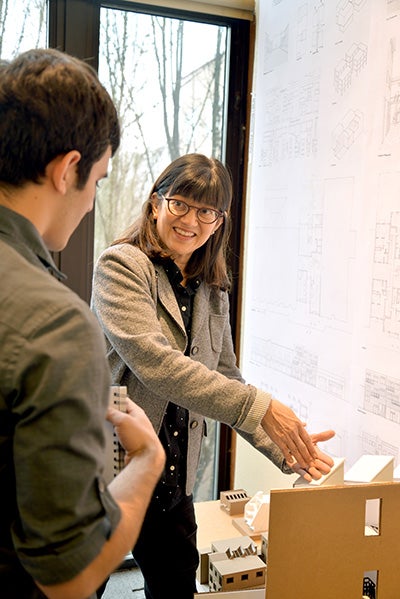Department of Architecture Professor Alison Kwok is among the 25 Most Admired Educators for 2016, DesignIntelligence reports.
 “With an inspiring energy to educate students about sustainable design principles, Alison Kwok encourages them to expand on what they have learned through research,” DesignIntelligence states on its website. “She constantly seeks to better her students’ experiences and create well-informed architects.”
“With an inspiring energy to educate students about sustainable design principles, Alison Kwok encourages them to expand on what they have learned through research,” DesignIntelligence states on its website. “She constantly seeks to better her students’ experiences and create well-informed architects.”
Kwok says she tries to create real design experiences that “connect textbook principles, theory, and standards. I hope such experiences will provide an internal, almost instinctive understanding about the performance of buildings and the consequences of design decisions.”
For example, all of the lab sections of her lecture courses include “mini-design experiences” that incorporate core principles, such as solar tracking, shading device design, and heat transfer. Her studio exercises connect hand drawing, scale daylighting models (physical and digital), online tools, and evaluating design against basic passive principles.
“Alison Kwok has made an extraordinary contribution to sustainable design education for students and professionals in architecture,” says Judith Sheine, head of the UO Department of Architecture. “Her influence has spread far beyond the University of Oregon, with her Agents of Change project and The Green Studio Handbook, which have brought a new understanding of sustainable design principles and practices to architects and architecture students both in the US and abroad.”

Above: Professor Alison Kwok with a student during a review. “Many of her students have become faculty members teaching sustainable principles in schools across the US, further extending her impact on sustainable design education,” says Judith Sheine, head of the UO Department of Architecture. “Alison is very, very deserving of this recognition by DesignIntelligence.” Photo by Chloe Peterson.
The Green Studio Handbook: Environmental Strategies for Schematic Design (Elsevier, 2007, 2011), coauthored by Walter Grondzik, provides a resource for students and practitioners to help integrate green strategies into the beginning stages of design.
Kwok is quick to proudly point out her students’ accomplishments.
“I really enjoy working on case study projects where students are learning multiple design skills and can take it to the next level, such as sharing that information through the UO Grad Forum, UO Undergraduate Symposium, and many national and international conferences.” Gatherings where her students have won awards or otherwise excelled include the American Solar Energy Society, Passive Low Energy Architecture, North American Passive House Conference, and the American Society of Heating Refrigeration and Air Conditioning Engineers.
“Oregon students seem to have a quiet, 'I can do it' kind of philosophy and get the most they can out of their education,” she says. “Also we have found that students who get ‘geeky’ in wanting to understand building systems have found success in their career endeavors. The journey is a lot of fun.”
In addition to teaching, Kwok, who joined the UO faculty in 1998, serves as director of the architecture graduate program, director of the Technical Teaching Certificate program, and as PhD student advisor.
Kwok also serves as a role model for design students who choose to enter academia, Sheine notes. “Many of her students have become faculty members teaching sustainable principles in schools across the US, further extending her impact on sustainable design education. Alison is very, very deserving of this recognition by DesignIntelligence.”
Among previous honors, Kwok received a Distinguished Service Award in 2012 from the American Society of Heating, Refrigerating and Air Conditioning Engineers. She was recognized for, as UO student chapter advisor, working to foster better communication between architects and engineers on building design. She also was noted for her course “Cool Tools for Building Performance,” which was presented at an ASHRAE conference.
The New York Times has reached out to Kwok for her expertise on passive cooling, quoting her in a story about alternatives to conventional air conditioning.
In addition to The Green Studio Handbook, she has authored Mechanical and Electrical Equipment for Buildings, 12th edition; annual books documenting case studies from Environmental Control Systems; and, with students in her NetZED Case Study Laboratory, co-authored the Porterville Courthouse Case Study.
Kwok has a PhD and MArch from the University of California Berkeley, a MEd from University of Hawai‘i Manoa, and bachelor’s in biology and art from Knox College. She is a registered architect in Oregon and California and holds NCARB and Certified Passive House Consultant certifications.
Kwok joins colleagues in the DesignIntelligence Top 25 from schools including Harvard, Notre Dame, Rice, Cornell, and Princeton, among others. Former UO Department of Architecture Head Christine Theodoropoulos was also in this year’s 25 Most Admired Educators. Theodoropoulos served on the faculty at UO for nine years before becoming dean at the College of Architecture and Environmental Design at Cal Poly San Louis Obispo in fall 2012.
Previous UO faculty members in the Top 25 Most Admired Educators list are: Kiersten Muenchinger (2015), Frances Bronet (2014, 2011), Anne Godfrey (2014), David Hulse (2012), and Linda Zimmer (2007).
The education role models are selected by DesignIntelligence staff with input from thousands of design professionals, academic department heads, and students.



Above left: The Green Studio Handbook provides a resource for students and practitioners to help integrate green strategies into the beginning stages of design. Above middle: Kwok coauthored the industry standard Mechanical and Electrical Equipment for Buildings, 12th edition. Above right: In partnership with the US Green Building Council, The Kenyon House Case Study brings to life the visioning, design, construction, and operation of Kenyon House, a LEED Platinum affordable housing complex (18 units) in Seattle for formerly homeless people living with HIV and AIDS. The project was designed by SMR Architects, Christina Bollo ’15 (first PhD from UO Department of Architecture) and a recipient of the 2015 Graduate Teaching Excellence Award). Kwok served as Bollo’s mentor for her MArch.
